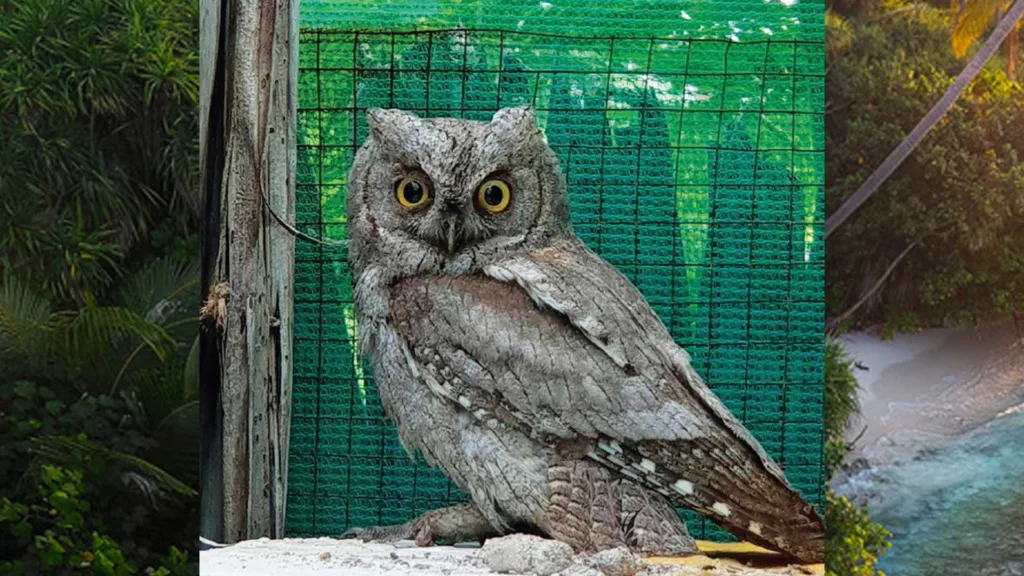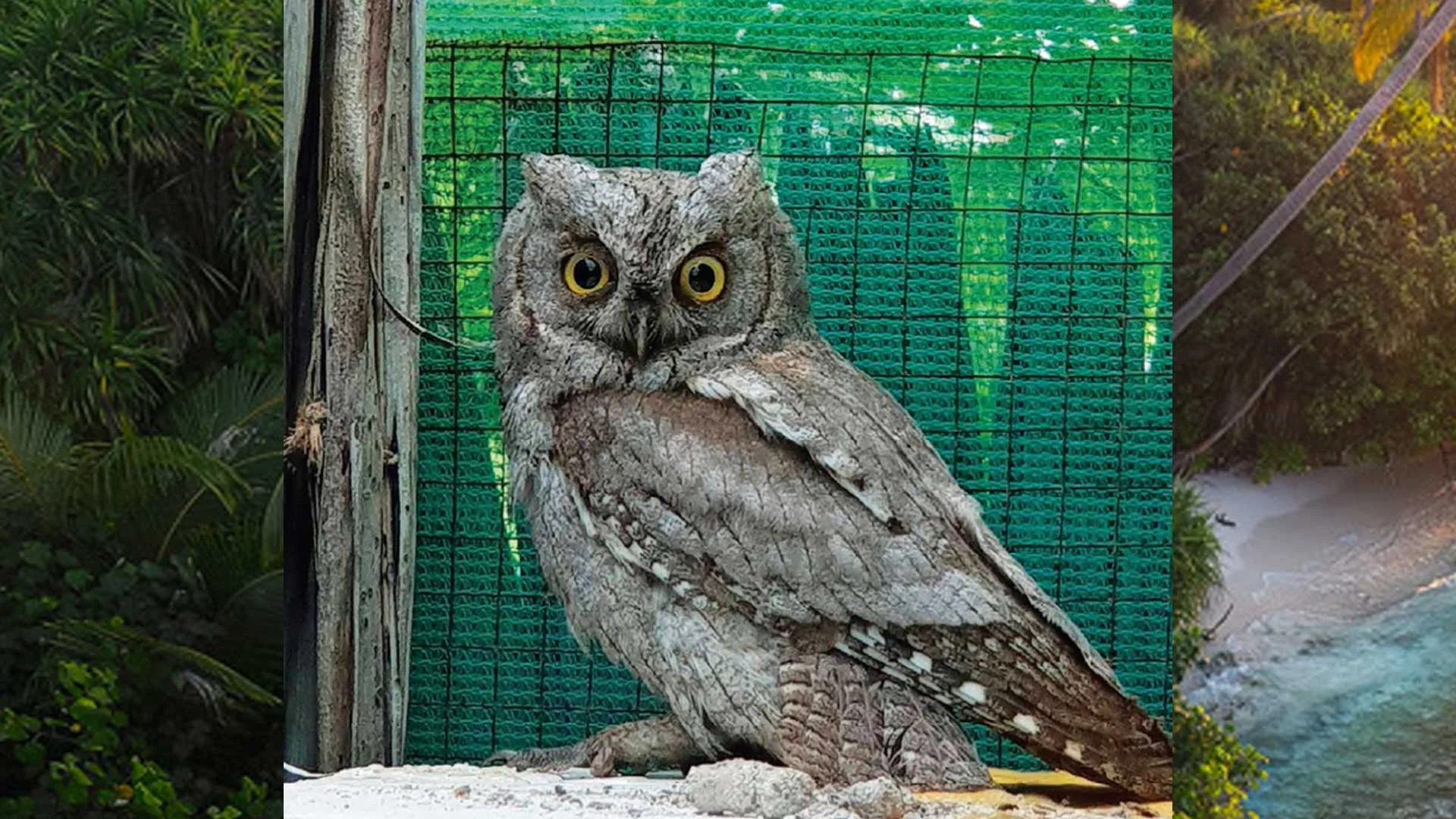
In 1984, on the island of Fuvahmulah, I witnessed a rare and unforgettable moment: an owl captured near the calm shores of the Dhadimagu freshwater lake, one of the island’s most cherished natural treasures. For a brief time, it was kept in a house within our district, a creature both fascinating and unsettling to the locals. An owl, a creature rarely seen in these parts, had been captured by a local. Word travelled fast across our district. Before long, the bird had become a quiet attraction in the household where it was kept, its large amber eyes observing us with an intensity that felt foreign, almost unsettling, to islanders who had grown up without seeing such creatures perched in our coconut palms.
Owls have long had a complicated place in Maldivian culture. As recorded by J.S. Ash and Ali Shafeeg in their authoritative work Birds of the Maldives, Indian Ocean, these birds were once considered irregular winter visitors, sometimes appearing in remarkable numbers. Yet despite their rarity—or perhaps because of it—they were traditionally regarded as bad omens. An owl’s sudden appearance near a home was seen by some as a sign of impending misfortune. As a result, many were killed on sight throughout the atolls. Historical records list sightings from B. Goidhoo, Fehendhoo, N. Kendhikulhudhoo, Malé, and as far south as Seenu, Gaafu Alif, and Gaafu Dhaalu. These entries offer a faint but fascinating glimpse into an avian world that once brushed the edges of Maldivian life.
Although the Maldives is world-famous for its turquoise lagoons, overwater villas, and coral reefs, the story of its birdlife—especially these fleeting visitors of the night—adds another layer of wonder for travelers who venture beyond the postcard settings. And sometimes, these encounters unfold in the most unexpected places. More than three decades after my own childhood sighting, another owl appeared in the atolls, this time captivating not just a neighborhood, but the country’s naturalists and bird enthusiasts.

On 28 November 2018, members of the Maldives Biodiversity Association discovered a lone Pallid Scops Owl (Otus brucei) resting quietly on the sandy shoreline of Gulhifalhu, a low-lying reef platform near North Malé Atoll. The coordinates—4°14.9’N, 73°22.6’E—pinpoint a spot surrounded by the deep blue of the Indian Ocean, hardly a place where one expects to find a migrant owl far from its usual wintering grounds. The bird was gently taken into care for one night before being released the next morning, unharmed.
At first, photographs taken by Ahmed Samaan circulated online with the assumption that the bird was a familiar Eurasian Scops Owl (Otus scops). But subtle details soon told another story. The plumage was pale grey and finely streaked; the facial disc was clean and rufous-free; the underparts lacked the characteristic crossbars one might expect in other species. The scapulars carried only the faintest hints of brown, and the upper parts displayed thin, contrasting streaks rather than bold blotches. These distinctive features confirmed the bird as a Pallid Scops Owl, a species that typically spends its winters in Pakistan and northern India—reaching no farther south than Maharashtra, according to Rasmussen & Anderton (2012).
But bird migration often defies expectations. More recent sightings in Kerala and Tamil Nadu indicate that this species travels deeper into southern India than previously thought. From there, a brief oversea journey to the Maldives no longer seems implausible. For naturalists, the Gulhifalhu owl was a thrilling reminder that even small, low-lying islands in the middle of the Indian Ocean can serve as stepping stones for remarkable travelers of the night sky.
Yet not all owl stories in the Maldives are so contemporary. Another species, the Short-eared Owl (Asio flammeus), holds a far more enigmatic place in the archipelago’s history. Although Ash and Shafeeg once described it as an “irregular northern winter visitor, sometimes in considerable numbers,” the records tell a more mysterious tale. The only confirmed sightings date back to 1899–1900, when naturalists Gadow and Gardiner documented one specimen and five additional sightings during their travels through the islands. After this brief flurry of observations, the species appears to have vanished from the Maldives entirely. Even W.W.A. Phillips, one of the most meticulous chroniclers of regional birdlife, never encountered it personally—though he believed Maldivians recognized it. Today, ornithologists suspect that these sightings may have been the result of a single irruption, a sudden surge of winter migrants driven unusually far south by climatic conditions more than a century ago.
For travelers tracing the subtle natural history of the Maldives, these owl stories reveal a side of the islands often overshadowed by beachside bliss. They speak of unexpected arrivals, shifting winds, and centuries of cultural folklore that continue to shape how islanders view the natural world. While most visitors come seeking sun and sea, a deeper curiosity—one that wanders through freshwater lakes, marshlands, and quiet sandbanks—may just uncover moments where myth and migration converge. And every so often, under the soft glow of a Maldivian moon, a rare silhouette may remind us that even paradise has its secrets.




